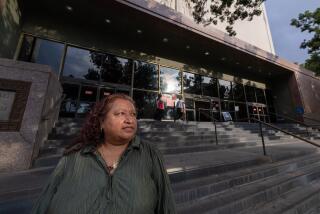Building’s New Name a Testament to Tenacity
What do Richard Riordan, Ronald Reagan, Kenneth Hahn and Clara Shortridge Foltz have in common?
They’re buildings. Or at least they have public buildings in downtown Los Angeles named after them.
The christenings of the Ronald Reagan State Building and the Kenneth Hahn Hall of Administration took place years ago with strong community support.
The recent naming of the Richard J. Riordan Central Library by his own Library Commission appointees drew criticism.
On the other hand, the recent naming of the Clara Shortridge Foltz Criminal Justice Building--a.k.a. the Criminal Courts Building--has drawn a chorus of people saying: “Clara who?”
Foltz, born in 1849, is unknown to most present-day lawyers even though she was the first woman admitted to the state’s first law school--Hastings College of Law in San Francisco--and was the first woman admitted to practice law in California, the first woman to serve as a deputy district attorney in Los Angeles County and a founder of the public defender system in the United States.
Foltz also established a newspaper (the now-defunct San Diego Bee), helped start the Women Lawyers Assn. of Los Angeles and even ran for governor in the early 20th century.
And she was the single mother of five children. For that alone she should be honored--but that’s another story.
Her husband left her when their children were young, so Clara needed a job. She worked in a law office, fought to get into law school, then took the bar exam and passed. Every step was a battle--male lawyers and legislators routinely told her she belonged at home with her children, or so the story goes. She fought for women’s rights along the way, changing laws when necessary.
Foltz died in 1934.
A Stanford University professor is writing a book about her, and she is mentioned here and there in history books, but she hadn’t had a building named after her. Until now. And imagine: She wasn’t even a wealthy campaign contributor. Go figure.
The Los Angeles County Board of Supervisors recently agreed to rename the famous yet ugly courthouse on a proposal by Supervisor Yvonne Brathwaite Burke, a lawyer herself.
So the signs are being produced, a task force has been convened, and in February the dedication ceremony will include the likes of U.S. Supreme Court Justice Sandra Day O’Connor (she’s already RSVP’d).
The idea to change the name of the building was no joke. But it came about as a result of jokes. Lots of them.
During a speech nearly two years ago, U.S. Court of Appeals Judge Arthur Alarcon suggested that the legal profession do more to boost its reputation by honoring colleagues who are going unnoticed. At a lunch at a Chinese restaurant after the speech, Alarcon, members of the Los Angeles County Bar Assn. and others talked about the low opinion many people have of attorneys in general.
“We wanted to turn the tide of lawyers’ jokes--some of which were perfectly appropriate,” said retired Superior Court Judge Warren Ettinger. “We talked about what we could do to instill in younger lawyers the pride of being a lawyer.”
Alarcon came up with Foltz’s name after talking to a historian in the public defender’s office--well, a public defender who knows a great deal of the office’s history.
But after 30 years of calling the courthouse the CCB, will anyone use the new moniker?
Defense attorney Mark Geragos notes that the building has been called quite a few names in its time.
“[Yet] the CCB is so ingrained in the culture I can’t see it ever changing,” he said.
Commented loquacious defense lawyer Harland W. Braun, who has spent more than a little time in the building: “I’m not going to lead a demonstration against [the new name], but I’d probably just ignore it. At least it’s not Ronald Reagan. . . . There’s almost as many Ronald Reagan buildings as there are Starbucks.”
Dist. Atty. Steve Cooley, whose office is on the 18th floor of the courts building, says he is a fan of Foltz. He has one reservation, however. “She was a magnificent, magnificent woman. I just wish her name was a little shorter,” he said.
Lawyers, bailiffs and others who work in the building say the name will probably be shortened. The CSF, for example, or the Foltz Building. Some might get confused and call it the Bob Foltz Building. He is a deputy district attorney and Clara’s great-nephew.
“I don’t think it’s important what they call it,” Ettinger said. “I just will sleep well at night knowing we have made a little contribution to who this lady was.”
The building itself has a storied history. It has been the site of some of Los Angeles’ most infamous trials: the O.J. Simpson and Heidi Fleiss criminal cases in the 1990s, and the Night Stalker, McMartin Pre-School and “Twilight Zone” trials in the previous decade.
The concrete and glass structure just might have looked bad even when it opened in 1971.
It is also home to some of the worst elevators in town. Aside from those in City Hall, that is. Try getting to the 13th floor of the courts building on a Monday morning at 8:30 when a judge is setting the master calendar.
Maybe the elevators should be named after someone. “I have a few people in mind, but I won’t name them,” quipped Cooley.
Then there’s the cafeteria. That truly is another story.
Now, have you heard the one about the lawyer?
Sorry, Clara.
More to Read
Sign up for Essential California
The most important California stories and recommendations in your inbox every morning.
You may occasionally receive promotional content from the Los Angeles Times.










